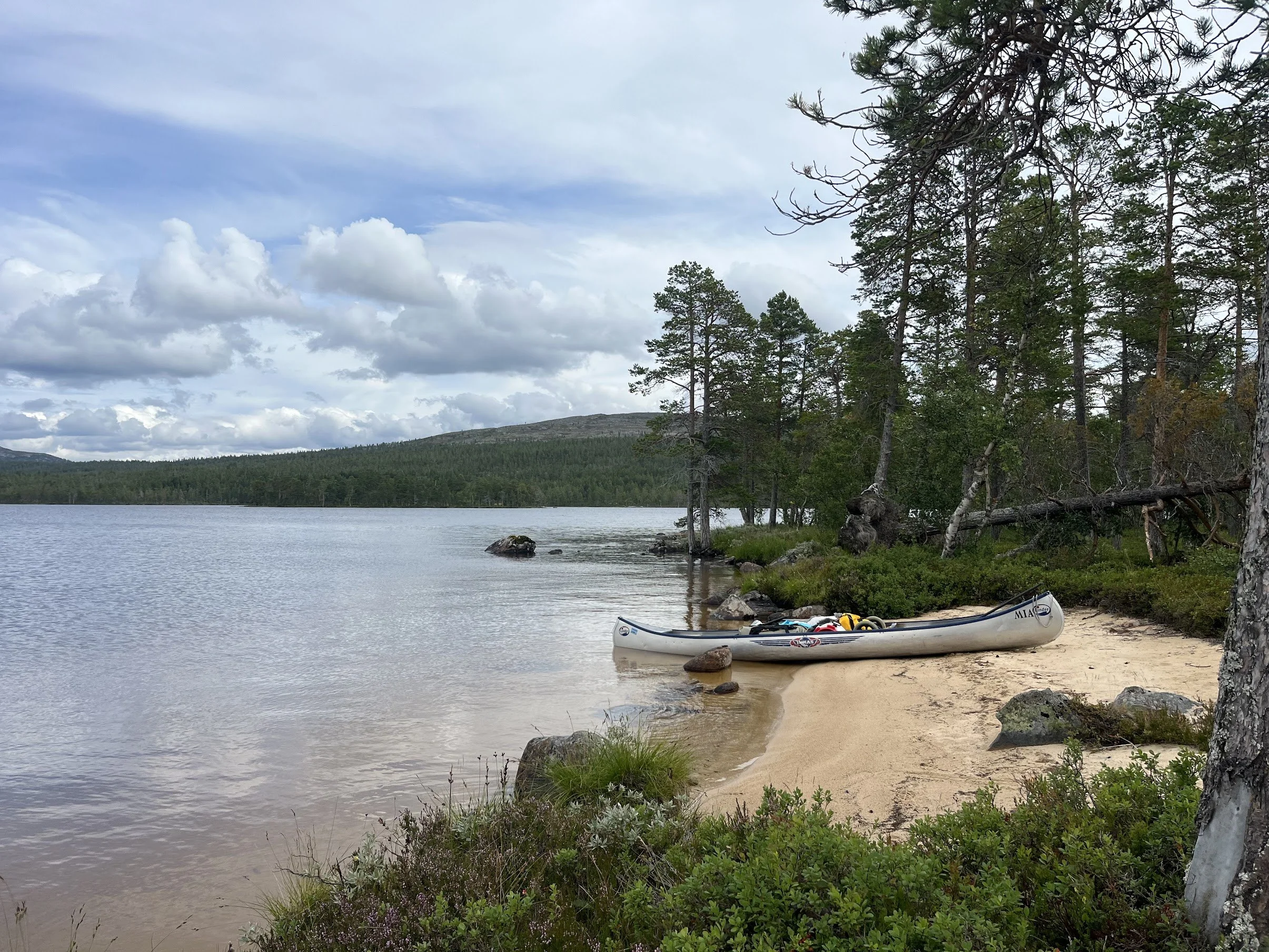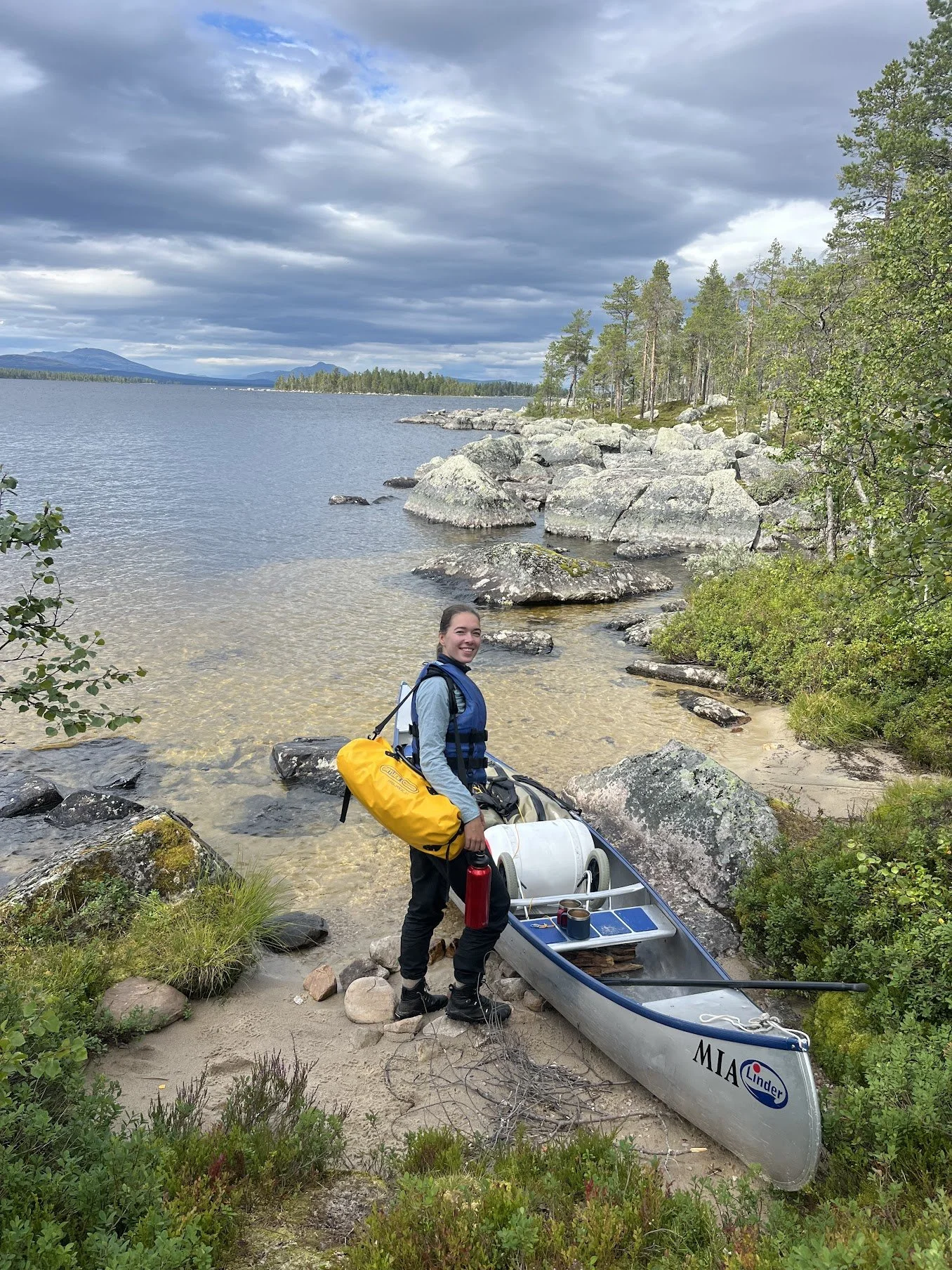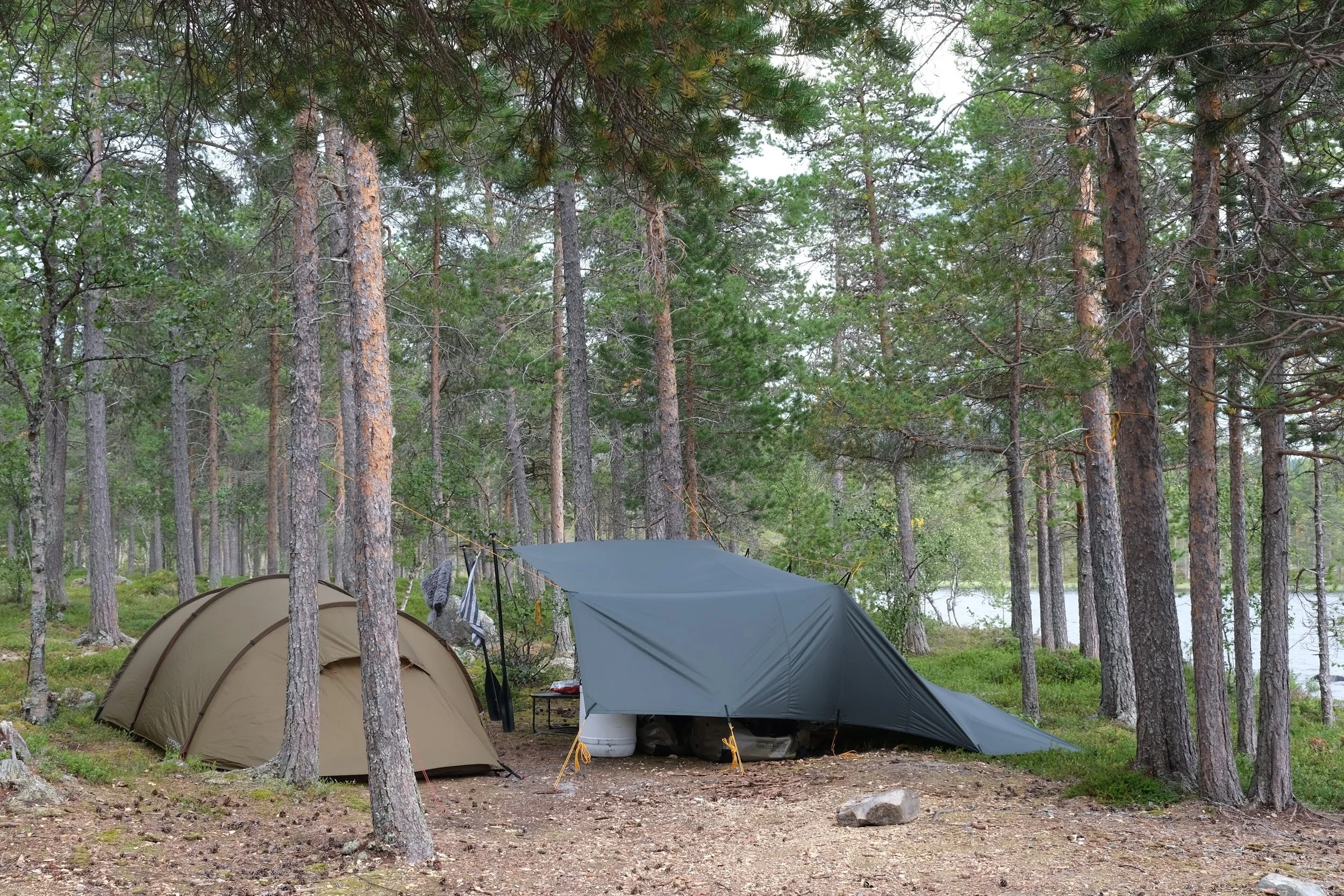5-day canoe trip in Norway
5 days, 1 canoe, 3 large bags and some stormy Norwegian weather. In august 2024, we wanted to challenge ourselves and take a trip into nature. We decided on a canoe trip, planning for 7 days on the water. We would be taking everything we thought we might need in a small boat with 2 paddles and see where the wind would take us. Are you wondering if such a trip is for you, then read on!
Our plan
Scanning through travel books at home, we stumbled upon Femund Canoe Camp, a wildernis camp in the middle of Norway close to the Swedish border. Here they rent out canoes for however long you’d like, from 2 or 3 days, to more than 3 weeks. Intrigued by the possibility we started planning. After reading through their site, we decided to rent a canoe for 7 days and 6 nights. We would take around 5 days to drive up to the camp from the Netherlands by car so we were able to bring anything we might need. In addition to booking the canoe, we also booked a trolley to transfer the canoe over land, and a large waterproof barrel to carry anything that needed to be kept dry. All that was left to do was check if we had all the gear needed and start packing!
The location
Femund Canoe Camp is a wildernis camp. This means several things. First of all, cars are not allowed outside of the parking area. We arrived late in the afternoon the day before we would start our trip. Included in the rental of a canoe is a stay on the campsite the night before and after your adventure. However, this does mean you have to carry all your stuff from the car to a spot on the property where you want to sleep. While we loved the premise of a campsite without designated spots and cars, it did mean we’d be carrying a lot of gear around. The night before we left we wanted to check our bags, see if we had everything etc. We ended up doing this partly right in the parking lot next to the car, and partly by carrying a lot of our gear to our sleeping spot to check everything over.
Upon arrival, we were greeted warmly and one of the employees sat with us to look over our route for the coming week. We booked the adventure called The beaches of Femund-Isteren. Together, we discussed our expierence level with canoeing (low) and determined a route. This would include a walking land transfer from lake Femund to lake Isteren. We were advised to only cross lake Isteren in a specific spot and if weather would permit and to always stay close to the lakes borders. In the end, we were given our canoe named Mia, the barrel, trolley, a sponge for excess water, and a small spade to take care of any number two’s on the way.
Note that while the campsite has running water, it does not have hot water! We returned from our adventure desperate for a hot shower, but had to wait until we got to our next destination. While they do have sauna that can be used if you’re willing to pay extra, other than that make sure you bring warm clothing.
Costs
We booked the BASIC package for 7 days at the camp. This package includes a 2 or 3 person canoe, paddles, life jackets, planning and instructions, car parking, and 1 night free camping at the camp before and after the trip. We added to this rental a watertight barrel and trolley for the land transfers. In total, this cost us 2615 Norwegian Kroner, which is around 225 euro. You can also rent other packages on their site, including for example all sleeping gear and food for the time you are away. However, since we own suitable camping gear already, and it seemed like a fun challenge to put together a food package for 7 days, we did not use these options.
Our canoe on the trolley, you can see the 68L watertight barrel in the back.
Setting of into the wild
After packing and checking all of our gear, we left the camp in our canoe early on the first morning. To get to lake Femund, you follow a small river, which helps you figure out how to navigate a heavy canoe together. From here we were advised to follow the lakes’ border to the south. Our goal for the first day was to reach a sandy beach on the other side of the lake, which would be a good starting point for the land crossing to lake Isteren on day two. Upon reaching Femund, we immediately noticed the wind that has fair play over a body of water that large. We made good progress and even spotted a reindeer with young within the first hour! At the end of the day we canoed a little over 13km in 4,5 hours and made it to our intended spot. We set up camp, gathered fire wood from our surroundings and even had another encounter with a reindeer. With tired arms and shoulders, our first day was a great succes!
The reality of Norwegian summer
On the second day, we packed up early and paddled another 4km towards the land-crossing point. Here, we heaved the canoe on land and put it on the trolley. What followed were 5 rough kilometers along the side of the road, pulling the canoe. The reason for this is that the rivier flowing between Femund and Isteren flows very quick, and is not suitable for a regular canoe. In addition, some of the earlier points where you could get to Isteren are on privately owned land, meaning we could not go there. After this tough walk however, we made it to a dock where we let our canoe back in the water, packed up, and set off again. And this is where it became difficult: it had been windy since we were in the canoe, but being on the opposite side of the lake than where the wind was coming from, led to quite big waves in the water, attempting to turn our canoe sideways and threatening to reach inside the canoe. It took us quite a while to figure out how to paddle along safely and this made us realise what we were doing was not without risk. The water in Norway is around 2-3 degrees celcius, meaning that flipping over could be a real problem. We paddled for another 8km before setting up camp and trying to stay out of the wind for the rest of the day.
On day three, we set of with high spirits and pulled the canoe trough about 200 meters of bog to get to a bit with gorgeous small beaches and almost no wind. Feeling bold, we decided we would try crossing Isteren, to be able to make a full loop around the lake. The weather would not get better later in the week so this was our best bet. This was quite harrowing, in the middle of the lake the current was even stronger and knowing the water temperature meant it was very important to make it across safely. We did, but in hindsight might have been safer of staying on our own side… In total, we canoed for 10,5km on this day. We did find a beautiful beach and the sun came back out! This called for a short and cold swim in the lake to freshen up and gave us the opportunity to make a campfire and watch a beautiful sunset.
Day four meant a lot of rain and even stronger headwinds. After about an hour of paddling (around 2,5km with the hard wind), we decided to stop at the next beach and set up camp. Luckily, we brought lots of tea, chocolate and other snacks. Listening to the rain on the tent while reading on our e-books was not that bad! During this day waiting out the weather, we also made the decision to cut our adventure short: day 6 and 7 were predicted to have windforce 7 or 8 which did not seem safe at all. We called the canoe camp, and decided that a pick-up at the dock on Isteren could be arranged. This cost us about 40 euros but felt like the right choice.
Our fifth, and what would turn out to be final day on the lake, started with beautiful sunshine. It was about 10km to the dock, and we made good tempo to get there on time. Here, we were picked up right on time by the camp. Upon arrival back, we warmed up next to a lovely fire: we made it!
The gear we brought
To tackle this adventure we needed the right gear. Doing a lot of research online, we ended up bringing 5 different bags, in addition to the barrel we rented. These roughly contained the following gear:
Two 110L waterproof duffels from Ortlieb containing:
3 persons tent: Nordisk Oppland 3.0
DD Tarp 4 x 4m
Axe and saw for processing firewood
2 Small camping chairs from Decathlon
Small firestarter kit
Small foldable table from Decathlon
2 Quilts from Enlightened Equipments
2 Sleeping mats from Thermarest
2 small dry bags containing wool clothing for sleeping, inflatable pillows and sleeping masks
2 large dry bags containing extra clothing (fleece, extra pair of pants, shorts, a clean shirt, underwear etc.)
Cooking equipment: gas canisters, a small MSR pot, 2 plates, 2 insulated mugs and 2 foldable cups.
2 1,5 liter water bottles from Sigg
Water shoes
Toiletry bag including toothbrush, eco soap, sunscreen and bug repellent
Extra cord to set up the tarp or a clothesline
2 quick-drying towels
Lamp: NEBO Galileo AIR 1000
31L Rack-Pack by Ortlieb - this functioned as our ‘bail-bag’ and contained all the necessities:
Map and compass
Basic cooking equipment: MSR Pocket Rocket, a small gas canister and Toaks pot 900ml and sporks
Food for the day - snacks/lunch etc.
Electronics bags: power banks, cables, e-readers, solar panel
Sawyer Squeeze water filter
2 1 liter water bottles from Sigg
2 dry bags with extra layers: puffy, rain coat and pants
Camera + equipment
Toiletry bag including our poop-kit
EHBO-kit
Headlamps
A small towel
Two 4L Belt Packs by Lowe Alpine - these were on us at all times:
Small snacks for the day
Gloves, sun cap, warm hat and buff
Phones
Garmin Inreach
Pocket knife
68L watertight barrel - this barrel contained all our food for 7 days, roughly:
14 oatmeal based breakfasts
14 dinners, about half were freeze-dried meals
Lots of crackers, nuts and other snacks that could be eaten as lunch
Fresh produce including apples, bell peppers and avocado’s
Marshmallows
A few cans of coke and non-alcoholic beer
Cup-a-Soup and instant noodle packets
Finally we brought two sit-pads to use inside the canoe while paddling, this was a life safer! We also brought two sheep skins for both in the canoe and the evenings to keep us warm.
Final thoughts
We went looking for an adventure and we certainly found it! We really enjoyed our time on Femund and Isteren, but also found it a bit more adventurous than planned beforehand. This was mainly due to the weather: if we had been a week earlier there would have been sushine all the way. Still, this is Norway so bad weather should be expected. Our main point of improvement would be toward the place where rented the canoe: after they gave us the canoe they simply asked when we expected to be back. Until then, they would not worry about us. In our opinion, it would have been nice to have some sort of daily contact point. For example an update about the weather, or advice which areas to go or avoid. We decided to cross Isteren, but it would have been nice to be in contact with someone more experienced than us. Overall however, we had a great time and would definitely go again.














